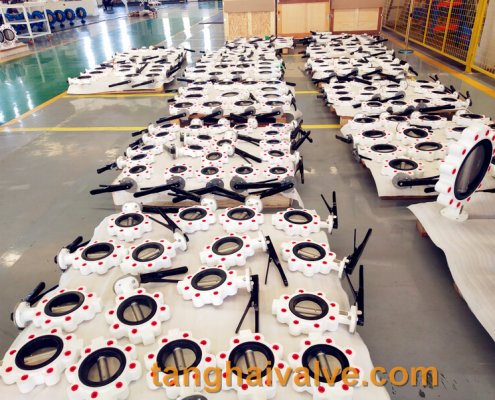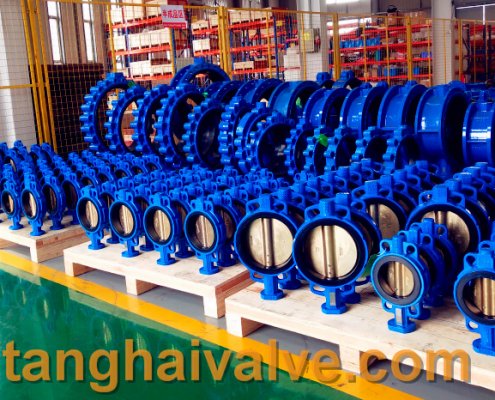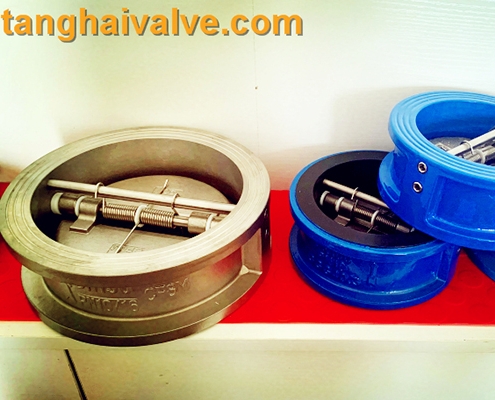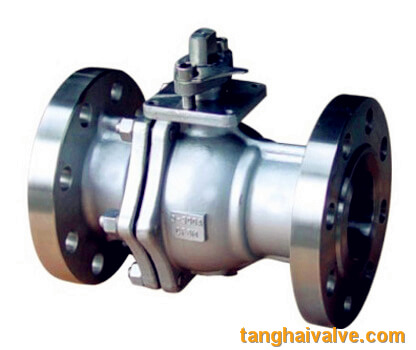Valve material and valve standards-(1)
What material is WCB/LCB/LCC/WC6/WC in the valve?
W, wrought casting; C, Carbon steel; A, B, C indicate the strength value of steel grades from low to high.

lug type butterfly valve-ductile iron
WCA, WCA, WCC represent carbon steel, ABC represents the strength level, and WCB is commonly used. The corresponding pipe material of WCB should be A106B, and the corresponding forging material should be A105.
WC6 is an alloy steel casting, the corresponding pipe material is about A355 P11, and the forging is A182 F11; there is also WC9, high temperature resistant alloy steel, the corresponding pipe material is about A355 P22, and the corresponding forging is A182 F22.
WC: weldable casting
LCB/LCC (ASTM A352) low temperature carbon steel
ITCS is carbon steel with impact toughness; impact test C=carbon S=steel (A350)
Split body split type, side entry side mounted (referring to the actuator), corresponding to TOP entry top mounted type
Commonly used valve casting and forging carbon steel material table
| material | country | standard | material grade name | ||
| Casting | China | GB/T 12229 | WCA | WCB | WCC |
| ZG205-415 | ZG250-485 | ZG275-485 | |||
| USA | ASTM A216/A216M | WCA | WCB | WCC | |
| UNS J02502 | UNS J03002 | UNS J02503 | |||
| Forged | China | GB/T 12228 GB/T 699 | 25 25Mn 35 40 A105 | ||
| USA | ASTM A105/A105M | A105 | |||
Low temperature casting parts material name and temperature range
| C | C | C-Mn | C-Mo | 2.5Ni | Ni-Cr-Mo | 3.5Ni | 4.5Ni | 9Ni | Cr-Ni-Mo |
| LCA | LCB | LCC | LC1 | LC2 | LC2-1 | LC3 | LC4 | LC9 | CA6NM |
| J02504 | J03303 | J02505 | J12522 | J22500 | j42215 | j31550 | j41500 | j31300 | j91540 |
| -32 | -46 | -46 | -59 | -73 | -73 | -101 | -115 | -115 | -73 |
Commonly used valve ASTM Casting and Forged material sheet (ASME B16.5)
| ASTM Casting | ASTM Forged | China name | Temp °C | suitable medium |
| Carbon steel | ||||
| A216 WCB | A105 | 20 | -29/427 | water,steam,air,petroleum products |
| Low temp Carbon steel | ||||
| A352 LCB | A350 LF2 | 16Mn | -46/343 | |
| A352 LCC | A350 LF2 | 16Mn | -46/343 | |
| High temp alloy | ||||
| A217 WC1 | A182 F1 | 20MnMo | -29/454 | High temp, High pressure medium |
| A217 WC6 | A182 F11 | 15CrMo | -29/552 | High temp, High pressure medium |
| A217 WC9 | A182 F22 | 10Cr2Mo1 | -29/593 | High temp, High pressure medium |
| A217 C5 | A182 F5 | 1Cr5Mo | -29/650 | Corrosive high temperature medium |
| A217 C12 | A182 F9 | Cr9Mo1 | -29/593 | High sulfur oxidizing medium |
| Martensitic stainless steel | ||||
| A217 CA15 | A182 F6a | Cr9Mo1 | -29/593 | High sulfur oxidizing medium |
| Austenitic stainless steel(C≤0.08) | ||||
| A351 CF8 | A182 F304 | 0Cr18Ni9 | -196/537 | corrosive medium |
| A351 CF3 | A182 F304L | -196/425 | corrosive medium | |
| A351 CF8M | A182 F316 | 0Cr18Ni12Mo2Ti | -196/537 | corrosive medium |
| A351 CF3M | A182 F316L | -196/425 | corrosive medium | |
| low carbon Austenitic stainless steel(C≤0.03) | ||||
| A351 CF3 | A182 F304L | 00Cr18Ni10 | -0.459016393 | corrosive medium |
| A351 CF3M | A182 F316L | 00Cr18Ni14Mo2 | -196/454 | corrosive medium |
| Special alloy | ||||
| A351 CN7M | B462Gr.NO8020 (ALLOY20) | -29/149 | Oxidizing medium and various concentrations of sulfuric acid | |
| A494 M-30C (Monel alloy) | B4564 Gr.NO4400 | -29/482 | Hydrofluoric acid, Sea water | |
| Hastelloy H.B H.C | Strong corrosive medium such as dilute sulfuric acid | |||
Notes:
1. Forged valve body material is dense, not easy to have defects, the structure size is not limited by the mold, and the pressure bearing performance is reliable. It is mostly used for high pressure, oxygen working conditions, small diameter or other small batch valve manufacturing, generally at high temperature, Choose forgings under high pressure or low temperature or special medium; castings are generally only suitable for medium and low pressure, and are mostly used for mass production of standardized molded valves.
2. The difference between material A351 CF3M and A182 F316L: the materials corresponding to the two standards are 316 stainless steel. CF3M stands for castings and is often used as valve material. The corresponding forging steel code is A182 F316L. ASTM A216 WCB is a casting, and its forging is A105; the casting of SS304 is A351-CF8, and the forging is A182-F304.






 © Copyright 2020 Tianjin Tanghaidongyang Valve Co., Ltd. All Rights Reserved.
© Copyright 2020 Tianjin Tanghaidongyang Valve Co., Ltd. All Rights Reserved.